![]()
This page is also available in French
![]()
Berlioz had fond memories of Florence. As he writes to his friend Ferdinand Hiller on his last passage through the city in 1832 (CG no. 270, 13 May):
[…] I was moved to see Florence again. It is a city which I love. Everything about it gives me pleasure – its name, its sky, its river, its timber beams, its palaces, its air, the grace and elegance of its inhabitants, its surroundings, everything, I love it, I love it… […]
Berlioz stayed in the city four times on his way to and from Rome: first around 1-5 March 1831 (CG nos. 211, 216), then the following month from 1-15 April when lack of news from his fiancée Camille Moke prompted him to return to France (CG nos. 216, 223), then more briefly around 28-30 May after his return from Nice (CG nos. 230, 231, 234), finally from 12-14 May 1832 or later after leaving Rome for his journey back to France (CG nos. 270, 271, 272bis). The chronology of events is established by Berlioz’s own letters at the time, while the later account in the Memoirs chapters 35 and 43) telescopes the perspective; in particular the Memoirs attribute to the third (and brief) stay of May 1831 events and experiences which belong in fact to the first two, especially the second.
The account in the Memoirs (chapter 35) reads as follows:
Among all Italy’s capital cities, none left in me such pleasant memories as Florence. Far from feeling consumed with spleen, as I was later in Rome and in Naples, a complete stranger who did not know anybody, with very limited available cash, and despite the huge drain on my finances caused by the escapade to Nice, I enjoyed as a result the most complete freedom and spent there some very pleasant days. I would either visit the city’s numerous monuments, dreaming of Dante and Michelangelo, or I would read Shakespeare in the delightful woods along the west bank of the Arno, where the deep tranquillity made it possible for me to voice my admiration aloud. Well aware that in the capital of Tuscany I would not find what I could at best hope for in Naples and Milan, I put music out of my thoughts, until conversations at table informed me that Bellini’s new opera (I Montecchi ed i Capuletti) was about to be performed. There was much praise for the music, but also for the libretto, which surprised me greatly in view of the Italians’ general indifference for the words in an opera. Ha, ha, this is something new!! After so many miserable operatic attempts at this fine drama, I am now going to hear a real opera about Romeo, worthy of Shakespeare’s genius! What a subject! How everything is designed for music!…
But Berlioz was very disappointed with the opera:
What a disappointment!! In the libretto there is no ball at the Capulets, no Mercutio, no chattering nurse, no solemn and composed hermit, no balcony scene, no sublime monologue of Juliet when she receives the hermit’s flask, no duet in the cell between the banished Romeo and the distraught hermit; no Shakespeare, nothing; a failed work.
Years later, in 1839, Berlioz gave a demonstration of what could be done with the subject in his choral symphony Romeo and Juliet. In 1859 he reviewed in detail Bellini’s opera when it was staged for the first time at the Paris Opéra (Journal des Débats, 13 September 1859); the review was later included by Berlioz in À Travers chants.
A few days after the performance of the work by Bellini, still according to the Memoirs (chapter 35), Berlioz went to see Pacini’s La Vestale:
Although what I already knew of it had convinced me that all it had in common with Spontini’s work was the title, I was not expecting anything of the sort… Once more Licinius was played by a woman… After a few moments of painful concentration, I must have exclaimed, like Hamlet [Act III, Scene II]: ‘Wormwood, wormwood’ and feeling incapable of swallowing any more of this I left in the middle of the second act, giving a furious kick at the floor, which hurt my big toe so badly that I felt sore for the next three days. — Poor Italy!… But at least, I will be told, in churches the musical pageantry must be worthy of the ceremonies it accompanies. Poor Italy!… That is what I heard with my own ears during my stay in Florence.
A letter to his father from Florence dated 2 March (CG no. 211) shows that it was during his first passage in the city that Berlioz heard Bellini’s opera: ‘Pathetic, ridiculous, feeble, worthless; this little fool did not fear that the shadow of Shakespeare might come and trouble him during his sleep; he would richly deserve it’ was his comment. The same applies to the opera by Pacini: ‘After the first act I had enough strength to run away’ he writes to Humbert Ferrand (CG no. 216, 12 avril). During this stay Berlioz will also hardly have failed to notice Benvenuto Cellini’s statue of Perseus in the Piazza della Signoria, with its famous inscription: ‘If any man offends you, I myself will be your avenger’ (Si quis te laeserit, ego tuus ultor ero) — years later, in 1838, the Florentine sculptor became the hero of Berlioz’s opera which bears his name.
Hardly had Berlioz moved on to Rome later in March that, driven to distraction by Camille Moke’s silence, he decided on impulse to return to Paris; he stopped on the way in Florence waiting for news from Camille. The account in the Memoirs (chapter 34) starts as follows:
While going through Florence I fell violently ill and was confined to bed for a week. […] During this week of suffering, I busied myself with re-orchestrating the Ball (2nd movement) of my Fantastic Symphony, and I added to it the present Coda. This was still incomplete when on the first day I was able to go out I went to the post office to ask for my mail. I was presented with a bundle which contained a letter of such extraordinary impudence and so hurtful to a young man as highly strung as I was then that something dreadful suddenly happened inside me. Two tears of rage darted from my eyes, and my decision was instantly taken. I must rush back to Paris and kill there without mercy two guilty women and one innocent man. As for taking my own life after this exploit, this was, as you can imagine, part of the ritual.
The chronology is again misleading. From a long letter Berlioz wrote from Nice to his friends in Paris and dated 6 May 1831 (CG no. 223), it appears that the stay in Florence in April was actually longer. In the letter he tells how after recovering from his illness [he] ‘spent days on the banks of the Arno, in a delightful wood a few miles from Florence, reading Shakespeare. That is where I read King Lear for the first time and screamed with admiration for this work of genius.’ He also relates, with macabre fascination, two funerals – one of a young woman, the other of a young relative of Napoleon (it may be that this prompted the idea of a large choral work on the Day of Judgement which he started sketching in Florence). It was only two days after these events that he received news of Camille Moke’s engagement to Pleyel and conceived the plan to return to Paris to exact a bloody retribution.
From Florence he went to Genoa, and on to Nice, but on the way changed his mind and decided to stay put. After spending a month in Nice he came back to Florence on his way to Rome (via Genoa again). Contrary to the account in the Memoirs (chapter 35), this third stay was in fact brief and uneventful, as is implied in a letter of Berlioz to his sister Adèle shortly after his return to Rome in early June (CG no. 230). But a letter to Humbert Ferrand the following month adds some interesting detail: ‘I found myself back in Florence, where I had spent such painful moments, with inexpressible delight; I was given the same room; I found there my trunk, my belongings, and my scores, which I was not expecting to see again’ (CG no. 234 [see vol. VIII], 3 July).
The sources are rather contradictory on Berlioz’s last stop in Florence in May 1832. The letter to Hiller cited above shows his joy at seeing the city again; but the Memoirs give a different view (chapter 43): ‘The sight of Florence, which I was entering for the fourth time, had a disheartening effect on me’. The same chapter also places at this point the account of the funeral of the young woman, an event which belongs unquestionably to the second visit. The tone of the letter to Hiller changes after the opening and ends with this confession: ‘What a sad and silly letter. I feel very downcast. Every time I have seen Florence again, I have felt disturbed and had a sense of inner turmoil which I can hardly explain to myself. There is nobody I know in Florence… Nothing adventurous has ever happened to me here… I am alone as I was in Nice… That may be the reason why Florence has such a strange effect on me. It is very odd. When I am in Florence I feel that I am no longer myself, but some stranger, a Russian or an Englishman walking along the beautiful banks of the Arno. I feel as though Berlioz is somewhere else and that I am one of his acquaintances’. But in a letter to his mother from Milan dated 21 May Berlioz states that in Florence he met many acquaintances (CG no. 271). Even the exact duration of his stay is unclear. In the letter to Hiller dated 13 May, the day after his arrival, Berlioz writes that he will be leaving ‘in three days’, in other words on 16 May, while in the letter to his mother he states that he only stayed three days in Florence (so too CG no. 272bis). During his last visit to the city Berlioz went once more to the opera and saw Bellini’s La Sonnambula, but he felt nothing but contempt for the work: as he put it to Hiller ‘You have to see Italy to get an idea of what they have the nerve to call music in this country!…’
![]()
Unless otherwise stated, all the pictures reproduced on this page have been scanned from an 1833 engraving and John L. Stoddards Lectures, Volume V – Paris La Belle France and Spain, by John L. Stoddard (Balch Brothers, 1898), both in our collection. © Monir Tayeb and Michel Austin. All rights of reproduction reserved.
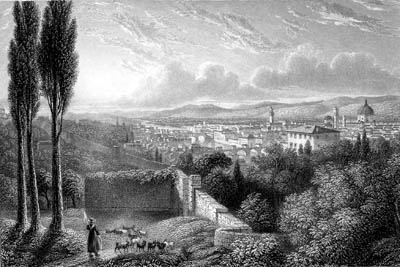
The original copy of this steel engraving, by E. Finden, has been donated by us to the Hector Berlioz Museum and they hold the copyright for it.
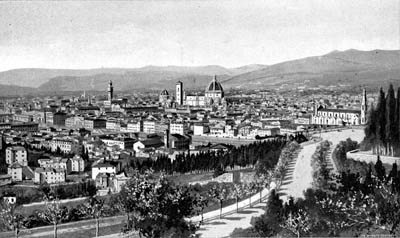
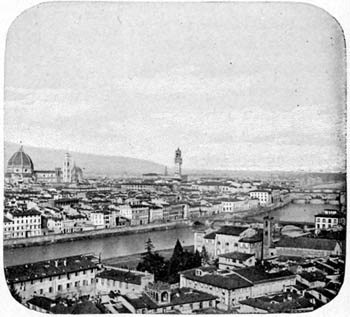
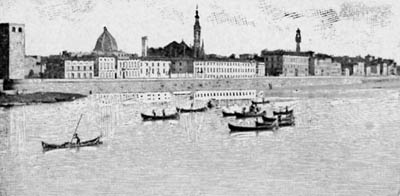
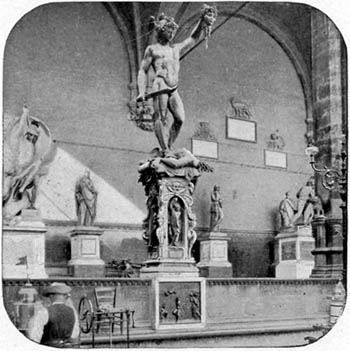
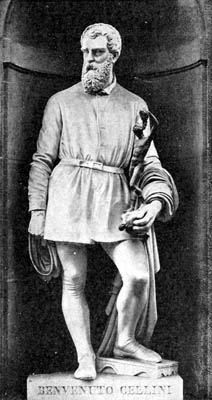
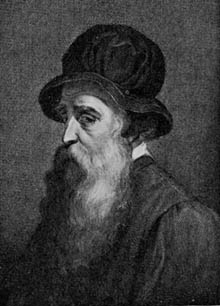
![]()
© Michel Austin and Monir Tayeb for all the pictures and information on this page.
Copyright notice: The texts, photos, images and musical scores on all pages of this site are covered by UK Law and International Law. All rights of publication or reproduction of this material in any form, including Web page use, are reserved. Their use without our explicit permission is illegal.